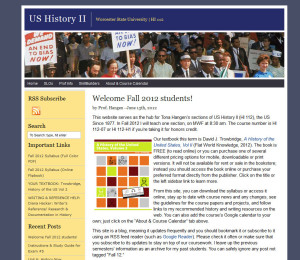Last week I talked about a nifty little assignment that builds basic skills of historical thinking and sourcing. Next week I’ll share more about syllabus design and organization, but this week I wanted to highlight another important tool in my history survey kit: the course website.
Our campus uses Blackboard as its course management system (CMS). Not everyone uses it, of course, and not everyone who uses it likes it. I count myself in that latter category. My objections are both aesthetic and ideological, but I don’t intend to turn this post into a rant against commercial systems. Suffice it to say that I eagerly anticipate the next, more user-friendly generation of CMS, and I’m a big fan of open source. In the meantime, “workaround” is my middle name.
Each term I create a minimal Blackboard presence – usually just some sidebar links, a folder with any material I don’t want to put on the open web, the student roster, and the online gradebook. It’s so minimal that I don’t need to export or save the Blackboard material from semester to semester. Instead, the real meat of my US history survey course goes into a WordPress blog on the open web and one of the Blackboard links points there. And there it stays.
Why a blog?
1. It creates a permanent presence and archive for my course from any computer. Current students can access it even during Blackboard updates or system burps. It shows up well on mobile devices including smart phones. Former students can retrieve a syllabus or course material long after leaving my class or graduating from the university. I can go back to see how I approached topics in previous semesters, since my memory is no better than Kevin’s.
2. It’s easy to customize with a modicum of html skills, which is pretty much all I have.
3. It teaches students about RSS feeds and blogs, which I would argue is a more useful skill than being able to navigate a proprietary, closed CMS digital world.
4. I should clarify – my students don’t blog for a grade; I just use a blog as a way to push course content in their direction.
Why WordPress?
1. It’s free and open-source. It looks professional.
2. There’s a built-in community of professors using it (see here and here).
3. I already use WordPress in other venues (blogging, research project management), and so the back end is familiar.
4. I like learning from mistakes, and I always make some when I think through presenting a course “from scratch” rather than using existing Blackboard templates. It does what I want it to, rather than living inside the limits of what’s possible in our campus CMS.
5. There are tools, widgets, and plug-ins like ScholarPress designed specifically to help WordPress work even better for course delivery.
What’s my system?
Although you can do this with a free account at WordPress.com, I don’t like not being able to customize their themes. Since I want to be able to tweak things, I maintain a personal web site and just host all my course sites there; my hosting service allows me to place a new WordPress install at a sub-domain without any additional cost.
First, I create a fresh WordPress install for each new course and import my favorite bare-bones theme. Then, I customize each class blog with a unique header image (often adapted from Creative Commons licensed images on Flickr) and color scheme (try Color Scheme Designer 3) which gives them a unified look, each one a different variation of the same basic template (for other examples see here, here, and here). The particular theme I use is an old one (“Nature’s Highlight” by ET, circa 2009 or so) and the designer doesn’t seem to exist any more, but it’s still my go-to. However, a plethora of other themes are suitable for courses too.
How does this improve my survey teaching?
It makes my course content and teaching style transparent not only to my students but to my colleagues and the wider discipline.
Because it’s on the open web, it feels more connected to the conversations happening there about history, teaching, sources, and ongoing controversies. I even get occasional comments from folks who aren’t taking the class.
It’s easy to post a video, embed a Powerpoint slide show, deliver a PDF, Tweet a lesson or link to web content.
I prefer it to Blackboard, so I’m happier. Period.
I really like WordPress as a “hacked” CMS, but there are other alternatives you could consider, including Google Sites, Wikispaces, Moodle, Instructure’s Canvas, Curatr in Great Britain, and Weebly (for K-12 educators).
Have you tried any of these? Liked them? Do you have advice or thoughts about putting course materials online and experimenting with one’s own course website design? Is this something that humanities folks should know how to do?




This is great. It is so hard to media re-tool beyond power point, but this really helps! As lame as this may sound in comparison, I created a google calendar for my TAs and have uploaded power points there so they can see them before students and be prepared for discussion
Love this, Tona. I was adjuncting at BYU this summer, and didn’t want to use their new Blackboard-replacement (Learning Suite) so I experimented with a WordPress blog. It worked great.
Fine information. Thanks so much, have a good day!
http://www.surveytool.com/course-evaluation-survey/